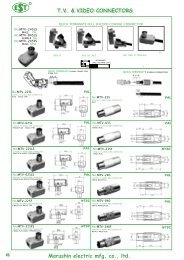Preferential Adsorption and Co-nonsolvency of ... - au one net
Preferential Adsorption and Co-nonsolvency of ... - au one net
Preferential Adsorption and Co-nonsolvency of ... - au one net
You also want an ePaper? Increase the reach of your titles
YUMPU automatically turns print PDFs into web optimized ePapers that Google loves.
Macromolecules ARTICLE<br />
between the bound molecules (majority rule). The co-<strong>nonsolvency</strong><br />
is <strong>one</strong> manifestation <strong>of</strong> such interesting nonlinear effects<br />
whose molecular origin lies in the cooperativity <strong>of</strong> H-bonds in<br />
polymeric systems.<br />
There have been several theoretical studies to elucidate the<br />
mysterious co-<strong>nonsolvency</strong> phenomena <strong>of</strong> PNIPAM in mixed<br />
solvent <strong>of</strong> water <strong>and</strong> methanol. The first <strong>one</strong> postulates that the<br />
main c<strong>au</strong>se <strong>of</strong> this phenomenon is the formation <strong>of</strong> a H-bonding<br />
<strong>net</strong>work (clustering) between water <strong>and</strong> methanol molecules<br />
(w-m). 20 According to this theory, the solvent composition at<br />
the minimum cloud point temperature must stay independent <strong>of</strong><br />
the polymer molecular weight. The observed sensitivity <strong>of</strong> the<br />
LCST line to the polymer molecular weight is difficult to explain<br />
based on this interpretation. Moreover, the observed hourglasstype<br />
co-<strong>nonsolvency</strong> 31 in the combination <strong>of</strong> water <strong>and</strong> ethanol,<br />
propanol is also difficult to explain bec<strong>au</strong>se no specific structures<br />
in these mixtures have been reported in the literature.<br />
The second interpretation stresses the importance <strong>of</strong> the<br />
composition fluctuation in the solvent mixture. 34 The preferential<br />
adsorption <strong>of</strong> <strong>one</strong> comp<strong>one</strong>nt near the polymer chains<br />
induces attractive interaction between the chain segments, as<br />
in the critical solvent mixture as described in the Introduction.<br />
<strong>Co</strong>mposition fluctuations may be important for the solvent pairs<br />
with partial miscibility, such as water <strong>and</strong> tetrahydr<strong>of</strong>uran<br />
(THF), which was shown to reveal LCST phase separation at<br />
the 0.2 mole fraction <strong>of</strong> THF <strong>and</strong> T =40°C. For a completely<br />
miscible pair, such as water <strong>and</strong> methanol, however, the correlation<br />
length ξ <strong>of</strong> the concentration fluctuations stays much<br />
smaller than the average radius Rg <strong>of</strong> gyration <strong>of</strong> a chain, so that<br />
a significant fluctuation effect is unlikely to occur.<br />
The third interpretation is the selective adsorption by<br />
competitive H-bonding. There are mainly two cases <strong>of</strong> the<br />
competition: (1) the primary solvent A (water) competes with<br />
the secondary solvent B (methanol) in forming H-bonds on the<br />
polymer chain, <strong>and</strong> (2) the secondary solvent B competes with<br />
the polymer in forming A-B<strong>and</strong>p-A H-bonds. The first case<br />
is what we have studied here. The second case occurs when the<br />
secondary solvent molecules take the bound water molecules<br />
away from the polymer chains. The LCST depression observed<br />
in aqueous PNIPAM solutions by added salts falls in this<br />
category, although the second comp<strong>one</strong>nt is not a solvent<br />
but hydrated ions. We have successfully described the observed<br />
co-<strong>nonsolvency</strong> phenomena from the viewpoint <strong>of</strong> the type (1)<br />
competitive H-bonding. The theoretical model developed here<br />
on the basis <strong>of</strong> the assumption (1) has however strict limitations<br />
in its application range bec<strong>au</strong>se other possibilities such as<br />
composition fluctuation, structure formation <strong>of</strong> the mixed<br />
solvents, the type (2) <strong>of</strong> competitive H-bonding, etc., have<br />
not been examined.<br />
Finally, we discuss potential application <strong>of</strong> our theoretical<br />
model to co-<strong>nonsolvency</strong> (reentrant volume phase transition)<br />
<strong>of</strong> cross-linked PNIPAM gels. 23 If the average sequence length ζh<br />
<strong>of</strong> the bound water molecules is shorter than the length n <strong>of</strong> the<br />
subchain connecting the cross-links, the cooperativity in hydration<br />
is not affected by the cross-links, <strong>and</strong> hence sharp collapse by<br />
temperature change is expected. 35 Under such conditions, bound<br />
water molecules are blocked by H-bonding <strong>of</strong> methanol molecules<br />
onto the polymer chains when they are mixed below the<br />
collapse transition temperature, so that dehydration, followed by<br />
the collapse, takes place sharply. If H-bonds <strong>of</strong> methanol has also<br />
cooperativity, the recovery to the swollen state also takes place<br />
sharply with increase in the methanol composition. Studies <strong>of</strong> the<br />
co-<strong>nonsolvency</strong> in cross-linked gels along this line will soon be<br />
reported in our forthcoming paper. 36<br />
’ ACKNOWLEDGMENT<br />
This work is supported partly by a Grant-in-Aid for Scientific<br />
Research on Priority Areas ”S<strong>of</strong>t Matter Physics” from the<br />
Ministry <strong>of</strong> Education, Culture, Sports, Science <strong>and</strong> Technology<br />
<strong>of</strong> Japan, <strong>and</strong> partly by a Grant-in-Aid for Scientific Research (B)<br />
from the Japan Society for the Promotion <strong>of</strong> Science under Grant<br />
19350057. We acknowledge their support.<br />
’ REFERENCES<br />
(1) Ewart, R. H.; Roe, C. P.; Debye, P.; McCartney, J. R. J. Chem.<br />
Phys. 1946, 14, 687.<br />
(2) Stockmayer, W. H. J. Chem. Phys. 1950, 18, 58.<br />
(3) Read, B. E. Trans. Faraday Soc. 1960, 56, 382.<br />
(4) Dondos, A.; Benoit, H. Polym. Lett. 1969, 7, 335.<br />
(5) Dondos, A.; Benoit, H. Makromol. Chem. 1970, 133, 119.<br />
(6) Wolf, B. A.; Willms, M. M. Makromol. Chem. 1978, 179, 2265.<br />
(7) Fem<strong>and</strong>ez-Pierola, I.; Horta, A. Polym. Bull. 1980, 3, 273.<br />
(8) N<strong>and</strong>i, A. K.; Sen, U. K.; Bhattacharyya, S. N.; M<strong>and</strong>el, B. M. Eur.<br />
Polym. J. 1983, 19, 283.<br />
(9) Schild, H. G.; Muthukumar, M.; Tirrel, D. A. Macromolecules<br />
1991, 24, 948.<br />
(10) Winnik, F. M.; Ottaviani, M. F.; Bossmann, S. H.; Garcia-<br />
Garibay, M.; Turro, N. J. Macromolecules 1992, 25, 6007.<br />
(11) Winnik, F. M.; Ottaviani, M. F.; Bossmann, S. H.; Pan, W.;<br />
Carcia-Gaibay, M.; Turro, N. J. Macromolecules 1993, 26, 4577.<br />
(12) de Gennes, P. G. J. Phys., Lett. 1976, 37, L59.<br />
(13) Brochard, F.; de Gennes, P. G. Ferroelectrics 1980, 30, 33.<br />
(14) Dondos, A.; Izumi, Y. Makromol. Chem. 1980, 181, 701.<br />
(15) Shultz, A. R.; Flory, P. J. J. Polym. Sci. 1955, XV, 231.<br />
(16) Yamamoto, M.; White, J. L.; MacLean, D. L. Polymer 1971,<br />
12, 290.<br />
(17) Yamamoto, M.; White, J. L. Macromolecules 1972, 5, 58.<br />
(18) Grabowski, C.; Mukhopadhyay, A. Phys. Rev. Lett. 2007,<br />
98, 207801.<br />
(19) Dua, A.; Vilgis, T. A. Macromolecules 2007, 40, 6765.<br />
(20) Zhang, G.; Wu, C. J. Am. Chem. Soc. 2001, 123, 1376.<br />
(21) Hirokawa, Y.; Tanaka, T. J. Chem. Phys. 1984, 81, 6379.<br />
(22) Hirotsu, S. J. Phys. Soc. Jpn. 1987, 56, 233.<br />
(23) Hirotsu, S. J. Chem. Phys. 1988, 88, 427.<br />
(24) Tanaka, F.; Koga, T.; Winnik, F. M. Phys. Rev. Lett. 2008,<br />
101, 028302[1-4].<br />
(25) Tanaka, F.; Koga, T.; Kojima, H.; Winnik, F. M. Macromolecules<br />
2009, 42, 1231.<br />
(26) Nordmeier, E.; Lechner, M. D. Macromolecules 1991, 24, 2529.<br />
(27) Shultz, A. R.; Flory, P. J. J. Am. Chem. Soc. 1952, 74, 4760.<br />
(28) Okada, Y.; Tanaka, F. Macromolecules 2005, 38, 4465.<br />
(29) Zimm, B. H.; Bragg, J. K. J. Chem. Phys. 1959, 31, 526.<br />
(30) Pol<strong>and</strong>, P.; Scheraga, H. A. Theory <strong>of</strong> Helix-<strong>Co</strong>il Transitions in<br />
Biopolymers; Academic Press: San Diego, CA, 1970.<br />
(31) <strong>Co</strong>sta, R. O. R.; Freitas, R. F. S. Polymer 2002, 43, 5879.<br />
(32) Xue, N.; Winnik, F. M.; Koga, T.; Tanaka, F., to be published.<br />
(33) de Azevedo, R. G.; Rebelo, L. P. N.; Ramos, A. M.; Szydlowski,<br />
J.; de Sousa, H. C.; Klein, J. Fluid Phase Equilib. 2001, 185, 189.<br />
(34) Hao, J.; Cheng, H.; Butler, P.; Zhang, L.; Han, C. C. J. Chem.<br />
Phys. 2010, 132, 154902[1-9].<br />
(35) Kojima, H.; Tanaka, F. Macromolecules 2010, 43, 5103.<br />
(36) Kojima, H.; Tanaka, F., to be submitted to Macromolecules.<br />
2989 dx.doi.org/10.1021/ma102695n |Macromolecules 2011, 44, 2978–2989












